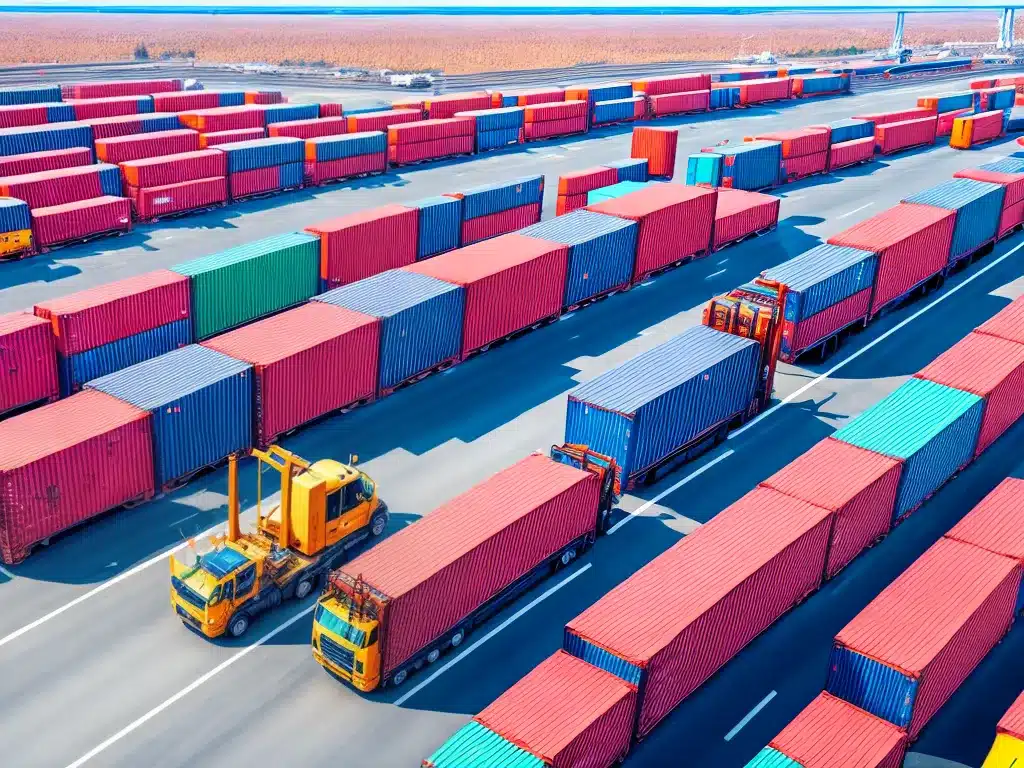
10 Ways IoT is Improving Transportation and Logistics
1. Real-time Tracking and Monitoring
The ability to track vehicles, shipments, and assets in real-time provides unprecedented visibility and control over supply chain operations. IoT sensors and GPS tracking allow companies to monitor the location and condition of shipments, ensure on-time deliveries, and quickly resolve any issues that arise during transit. This real-time tracking improves efficiency, reduces losses and damages, and enhances customer service.
For example, Maersk uses IoT sensors to track its refrigerated containers around the world. This allows them to monitor factors like temperature and humidity to ensure perishable goods remain in optimal condition. They can also track exact arrival times and locations to improve last-mile delivery and port operations.
2. Fleet and Asset Management
With IoT sensors on every vehicle, managers can closely monitor fleet operations. They can track vehicle locations, movements, mileage, and fuel usage. This allows for better route optimization, fuel efficiency, and predictive maintenance.
Sensors also monitor driver behavior and can help improve safety and compliance. Telematics systems provide real-time dashboard views of entire fleets for improved asset utilization and throughput.
For instance, FedEx outfits its delivery trucks with hundreds of IoT sensors that transmit data on vehicle condition, driver behaviors, and deliveries. This has helped them cut maintenance costs, improve safety, and increase per-vehicle package delivery.
3. Warehouse Management and Automation
IoT enables smarter warehouse operations through automated inventory control, asset/product tracking, and enhanced worker safety and efficiency. Sensors can identify when supplies are running low, monitor environmental conditions, and trigger alerts for potential hazards.
Warehouses can also implement advanced robotics and automation powered by IoT data. Systems can automatically scan pallets, retrieve items, and load shipments without human intervention. This improves warehouse throughput and minimizes errors.
Amazon uses over 100,000 IoT-connected robots in its fulfillment centers to automatically locate products, move shelves, and prepare orders. This has dramatically sped up processing, lowered labor costs, and improved accuracy.
4. Supply Chain Optimization and Coordination
The data insights supplied by IoT sensors allow logistics firms to better predict demand, coordinate suppliers, and optimize routes across the entire supply chain. This leads to lower operating costs, reduced waste, and minimal delays.
IoT increases collaboration and visibility across complex global supply chains. It allows suppliers, manufacturers, distributors to share key data like inventory levels, production schedules, and shipment locations. They can then adjust strategies accordingly.
Walmart utilizes IoT to collect billions of data points daily from its extensive supply chain. This has helped them enhance delivery times, minimize out-of-stock items, and streamline relationships with over 100,000 suppliers globally.
5. Improved Cold Chain Monitoring
Sensors enable real-time monitoring of perishable goods temperature, humidity, light exposure, and other metrics across the entire cold chain. IoT-connected refrigerated trucks, warehouse coolers, and store displays can trigger alerts if conditions fluctuate.
This allows transportation companies to ensure quality control for food, medical products, chemicals and more. It prevents losses due to temperature excursions.
For example, Maersk uses over 700,000 IoT-enabled refrigerated containers to precisely track cargo conditions throughout global delivery. This has reduced product waste by 60% for its perishable shipments.
6. Enhanced Delivery Management
IoT provides carriers with real-time visibility into delivery operations, empowering dynamic optimization as needed. GPS tracking allows dispatchers to continually monitor driver locations and make en-route adjustments to improve efficiency and on-time performance.
Sensors also enable self-service collection lockers and contactless, unattended deliveries. Customers receive alerts on mobile apps when packages arrive. This provides more flexibility in delivery options.
UPS uses a telematics system called EDDI (Enhanced Dynamic Delivery Information) to gather IoT data from its trucks. This has saved millions of miles and gallons of fuel by optimizing routes daily.
7. Better Cargo Security
IoT sensors can continuously monitor cargo and alert companies to any tampering, accidents, or anomalies during transit. GPS tracking shows if shipments stray from the planned route. Video cameras provide live footage of cargo holds and trailers to further improve security.
In one example, Monnit wireless sensors detected that a pharmaceutical trailer was unplugged from its power source for an unusual length of time. This triggered an alert, and the unchecked trailer was swiftly recovered undamaged. Such IoT monitoring deters theft and losses.
8. Predictive Maintenance for Vehicles
Onboard diagnostics and IoT sensors on engines, brakes, tires and more allow real-time monitoring of vehicle health. Fleet managers get alerts when parts need replacement or repair before a breakdown occurs.
This predictive maintenance reduces vehicle downtime and repair costs. It also prevents breakdowns and delays while cargo is in transit. All of this translates into improved uptime and service reliability.
9. Enhanced Driver Safety and Training
Sensors on commercial trucks track key metrics like speeding, hard braking, acceleration, and other risky behaviors. Fleet managers can coach drivers to improve techniques and encourage safer habits that also enhance fuel efficiency.
In-cabin video can also confirm seat belt usage, hands-free mobile usage and more. Tired drivers can be identified and required to rest based on driving patterns. Such IoT data promotes better driving skills and compliance with regulations.
10. Streamlined Billing and Payments
IoT automates much of the paperwork and documentation involved in transportation and logistics. Digital sensors and trackers provide timestamped proof of delivery and chain of custody. They enable seamless data sharing across platforms.
Transactions, billing, invoices, and payments can be automated using IoT data. This reduces administrative costs and minimizes potential errors from manual data entry or manipulation.
Overall, IoT unlocks transformative potential across transportation and supply chain processes. It provides unprecedented visibility while enabling intelligent automation, predictive capabilities, and streamlined operations. The result is smarter logistics with lower costs and higher customer satisfaction.












